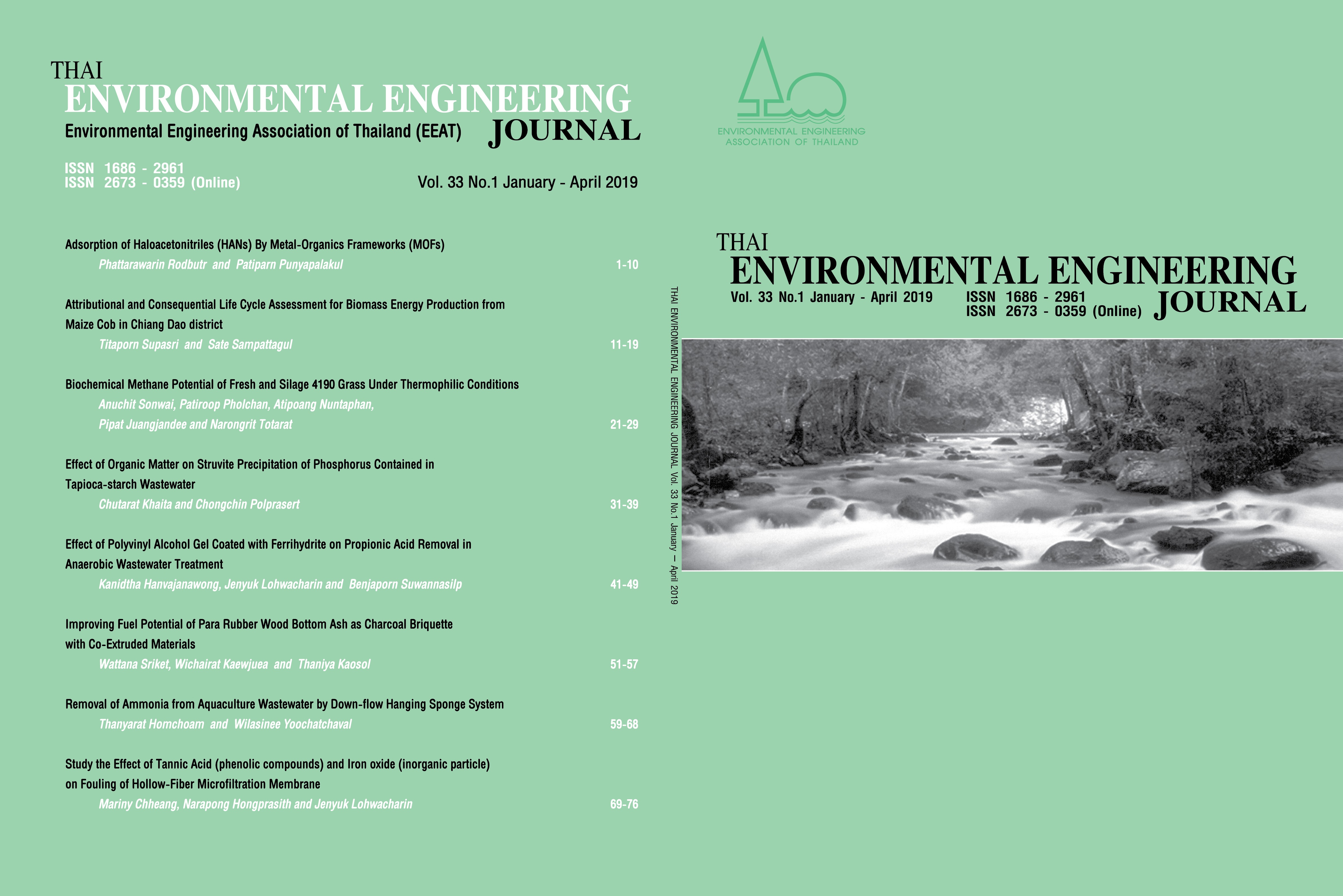Biochemical Methane Potential of Fresh and Silage 4190 Grass Under Thermophilic Conditions
Main Article Content
Abstract
Rapid population growth and expansion of industry have led to higher energy consumption while natural resources have been continuously decreased. Thus, making the pursuit of new energy sources is an urgent need. Thailand is noted as a country of agriculture, having high potential for producing energy crops that can be used to create renewable energy. The relatively high yield and fast growing 4190 grass is an interesting alternative for this purpose. This research was conducted to study the biochemical methane potential of 4190 grass. The modified Biochemical Methane Potential (BMP) test was conducted under thermophilic condition (55.4±0.73 °C) using 4190 grass aged 45, 70 and 90 d both in fresh and silage forms. The obtained methane yields could perfectly be fitted with modified Gompertz model (R2 ≥ 0.93). Total methane productions calculated from the model for the fresh and silage grasses of the same age were not significantly different, presumably thanks to the effect of digestion reaction at the thermophilic temperature. The highest methane yield of 199±7.77 NL/kg VSadded was attained when the fresh 4190 grass (45-d) was used as a feedstock. The bioreactor design and operation can be implemented from results gained for further study of the reactor performance under the continuous operation.
Article Details
References
[2] Seppälä, M., et al. 2009. Biogas production from boreal herbaceous grasses – Specific methane yield and methane yield per hectare. Bioresource Technol. 100(12): 2952-2958.
[3] Feng, L., et al. 2017. Anaerobic co-digestion of cattle manure and meadow grass: Effect of serial configurations of continuous stirred tank reactors (CSTRs). Biosyst. Eng. 160: 1-11.
[4] Himanshu, H., et al. 2018. Synergies from co-digesting grass or clover silages with cattle slurry in in vitro batch anaerobic digestion. Renew. Energ. 127: 474-480.
[5] Dussadee, N., K. Reansuwan, and R. Ramaraj. 2014. Potential development of compressed bio-methane gas production from pig farms and elephant grass silage for transportation in Thailand. Bioresource Technol. 155: 438-441.
[6] Chanpla, M., et al. 2017. Effect of harvesting age and performance evaluation on biogasification from Napier grass in separated stages process. KSCE J. Civ. Eng. 22(1): 40-45.
[7] Sawasdee, V. and N. Pisutpaisal. 2014. Feasibility of Biogas Production from Napier Grass. Energy Proced. 61: 1229-1233.
[8] KwaZulu-Natal Department of Agriculture and Rural Development, Giant Juncao Grass Cultivation in KwaZulu-Natal, in AGRI UPDATE, Research and Technology Bulletins. 2010.
[9] VDI 4630, Fermentation of organic materials-characterisation of the substrate, sampling, collection of material data, fermentation tests. VDI Guideline 4630. 2006, Verein Deutscher Ingenieure, Düsseldorf.
[10] Allen, E., et al., A detailed assessment of resource of biomethane from first, second and third generation substrates. Renewable Energy, 2016. 87: p. 656-665.
[11] Li, W., et al. 2018. Methane production through anaerobic digestion: Participation and digestion characteristics of cellulose, hemicellulose and lignin. Appl. Energ. 226: 1219-1228.
[12] Amon, T., et al. 2007. Methane production through anaerobic digestion of various energy crops grown in sustainable crop rotations. Bioresource Technol. 98(17): 3204-3212.
[13] Herrmann, C., C. Idler. and M. Heiermann. 2016. Biogas crops grown in energy crop rotations: Linking chemical composition and methane production characteristics. Bioresource Technol. 206: 23-35.
[14] Mancini, G., et al. 2018. Increased biogas production from wheat straw by chemical pretreatments. Renew. Energy. 119: 608-614.
[15] Voelklein, M.A., D. Rusmanis, and J.D. Murphy. 2016. Increased loading rates and specific methane yields facilitated by digesting grass silage at thermophilic rather than mesophilic temperatures. Bioresource Technol. 216: 486-493.


